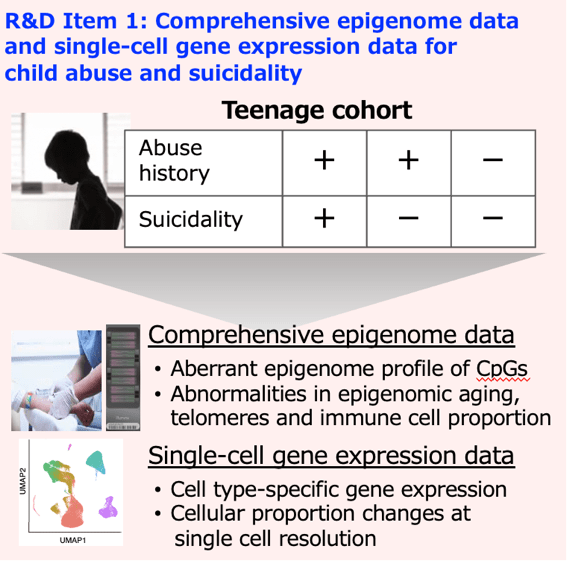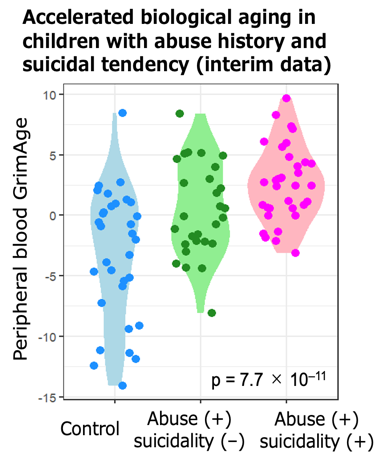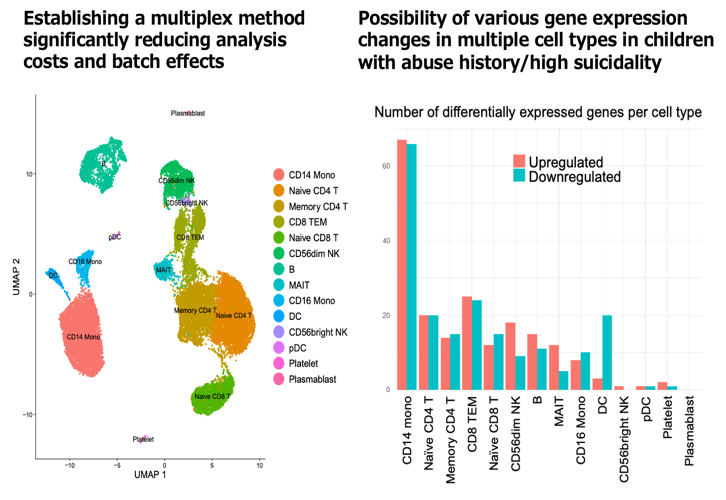Progress Report
Realization of a society where child abuse and suicide are zero[2] Comprehensive epigenome data and single-cell gene expression data for child abuse and suicidality
Progress until FY2023
1. Outline of the project
We aim to obtain comprehensive DNA methylation data from peripheral blood samples of teenage children with histories of abuse (with or without suicidal ideation/behavior) and children in the control group, and investigate whether the epigenetic signatures we previously identified in young suicide decedents, such as “epigenetic aging, telomere shortening, and increased NK cells”, are significantly more likely to occur in (1) children with histories of abuse compared to healthy children, and (2) among children with abuse history, in the group with suicidal ideation/behavior. In addition, we aim to perform single-cell RNA sequencing on blood samples from children with histories of severe abuse and suicidality (as well as some control children), and analyze gene expressions specific in cell type and cell composition ratios at single-cell level.

2. Outcome so far
We found that GrimAge (a measurement designed to most accurately predict healthy life expectancy among epigenetic ages) of children with histories of abuse were significantly accelerated compared to healthy controls. In particular, GrimAge was significantly accelerated in children with suicidality. We have also found that a short period of psychiatric treatment intervention can significantly reverse aberrant biological aging in the blood of depressed young patients. We believe these findings may provide positive perspective on the future of this research and development with important evidence that the aberrant biological aging that impairs the health of children with histories of abuse and suicidal tendency can be “reversible through care intervention”.

As one of the results from the interim analyses, we found machine learning models using some of the information from the comprehensive DNA methylation data that can predict the risk of youth suicide with high sensitivity and specificity. In addition, we have established a single-cell RNA sequencing experiment system using multiplexing methods to reduce costs and mitigate batch effects, and we are currently performing single-cell RNA sequencing of blood samples from children with histories of abuse and severe suicidal ideation/behavior (as well as control groups). As the result of interim analyses, we have found there may be changes in the number of immune system cells and the gene expression of multiple blood cell types in children with abuse history and severe suicidal tendency.

3. Future plans
We plan to collect samples on a scale that exceeds our initial expectations. In addition, based on the results so far, we have started to develop “biological aging indicators” and “markers to accurately reflect mental health conditions” that are specific to young people, using comprehensive DNA methylation data from peripheral samples. At the same time, we are working closely with experts in the field of emerging ethical, legal and social issues (ELSI) to precisely identify and discuss the benefits and risks of biomarkers to detect children exposed to severe stress.
Principal investigators (PIs)
OTSUKA Ikuo (Kobe University)
FURUYASHIKI Tomoyuki (Kobe University)